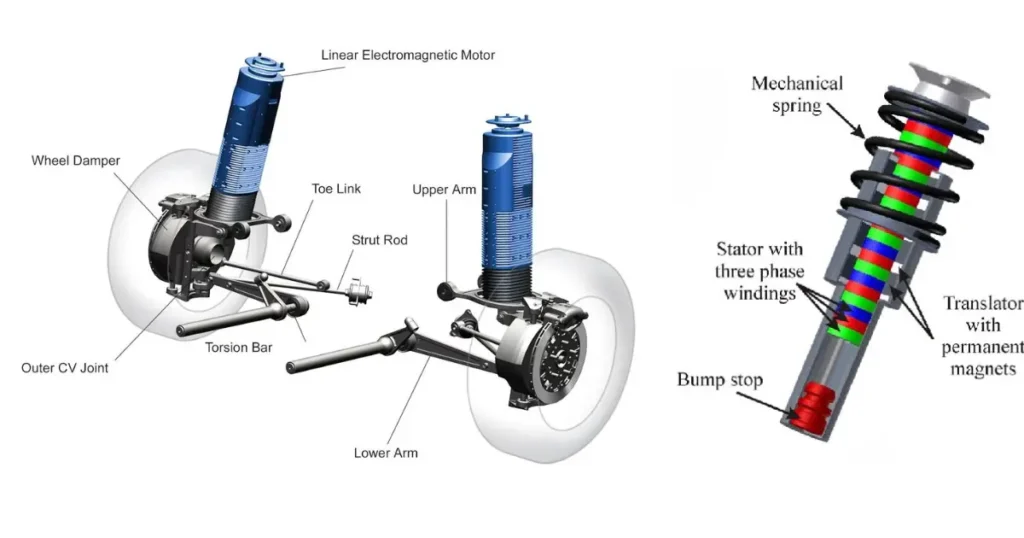The magnetic suspension system in the automobile is used for better rides and absorbs major shocks coming from the roads. The major principle of a suspension is to absorb the shocks from the road and this system is a revolutionary product in the automobile vehicle.
In this article, I will discuss the mechanism and working of a magnetic suspension system and the types of this suspension system.

Magnetic Suspension System
The magnetic suspension system uses the magnetic damper system to control the vibration from the roads. The traditional suspension system uses hydraulic oils and springs in major cars. These magnetic dampers easily control the damping and also easily return to their original place.
This suspension system helps to control the vehicle dynamics and the handling. This system also uses a tube but this tube contains a property called “Magnetorheological (MR) fluids“. This fluid has the property, that it can change its state to a magnet while jerking.
This magnet system helps to keep the upper body in a flexible up-side-down movement and helps the passengers to provide a hassle-free ride. The working principle of this system is discussed below.
Read More- What is an Air Brake System? Read the Working and Advantages.
Working of a Magnetic Suspension System
The magnetic suspension system also known as Magnetic Levitation or Maglev system helps to keep the vehicle maintain a even road contact with the tires. Vehicle load and a guideway, are the main two components of this system.
The vehicle load is equipped with powerful magnets and the guideway has a series of coils to generate magnetic field. The magnets on the vehicle and the guideway interact to produce a repulsive force, lifting the vehicle off the ground.
This system also uses the sensor to detect the load and the position of the suspension shrinking. Then the sensing data is sent to the ECU, according to that data, the system employs the position and orientation of the vehicle. Depending upon the data the magnetic field is adjusted and the vehicle geometry is also controlled.
When the vehicle shrinks, then it needs to push the vehicle upward for better stability. This time the magnetic field generates and pushes the vehicle upwards. This strength can achieved by strengthening the magnetic field by creating magnetic fields in the coils.
This system is fully controlled by the sensors. Sensors detect the speed and the load of the vehicle, this indicates the coils to create a magnetic field. This magnetic field helps to support the vehicle above and maintain a proper balance to the vehicle.
Read More- What is a Telescopic Suspension System?
Application of Magnetic Suspension System
This magnetic suspension system is not only used in automobiles. In many trains, this system is used to make the vehicle or that system fast. The applications of the magnetic suspension system are-
- Maglev trains use magnetic levitation to lift the train off the tracks, eliminating friction and allowing for very high speeds.
- Where there are shifting matters, there the magnetic suspension system is used.
- This type of system is used in rotating shafts to reduce the wear of the two rotating wheels.
- Maglev technology is sometimes used for creating captivating floating displays or art installations
- In some automotive vehicles, this system is used to provide good steering geometry and provides better handling.
- This system is also used in Metro trains to adjust the speed and vibration.
Read More- What is a Rigid Axle Suspension System?
Advantages of Magnetic Suspension System
The advantages of this suspension system are-
- This system helps smoother movement, reducing wear and tear on components and minimizing the need for maintenance.
- Maglev trains can achieve speeds significantly greater than conventional trains, leading to faster and more efficient transportation.
- This system helps to provide better traction on the road and also helps to keep the wheels on the road.
- This is especially advantageous in transportation and industrial applications where noise reduction is a priority, providing a more pleasant and environmentally friendly experience.
- The lack of wear and tear due to friction results in lower maintenance requirements for Maglev systems.
- This is valuable in applications such as scientific experiments, medical devices, and manufacturing processes where accurate and stable positioning is essential.
Read More- 5 Functions of Stabilizer Bar You Should Know.
Conclusion
The versatility of magnetic suspension systems makes them suitable for a range of applications where precise levitation, minimal friction, and stability are crucial. Ongoing research and development in this field continue to explore new possibilities and expand the scope of applications for Maglev technology.
Frequently Asked Questions(FAQs)
What are the main applications of Magnetic Suspension Systems?
Maglev technology is commonly used in high-speed transportation systems, such as Maglev trains, as well as in material handling, scientific research, medical devices, and various industrial applications.
Are Maglev trains in operation today?
Yes, Maglev trains are operational in some countries. One notable example is the Shanghai Maglev Train in China, which holds the record for the world’s fastest commercial train service.
Is Maglev technology used in any other modes of transportation?
Besides trains, Maglev technology has been explored for use in personal transportation, such as maglev cars and even maglev-based urban transportation systems.


Do comment here